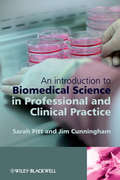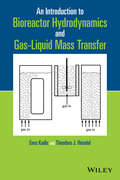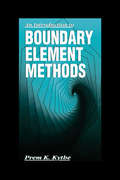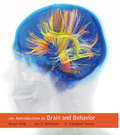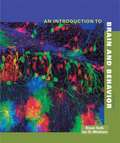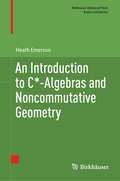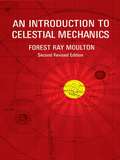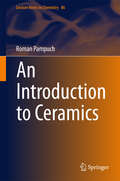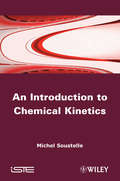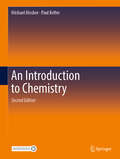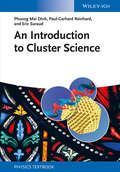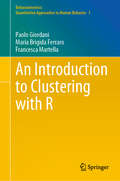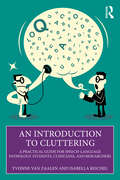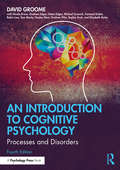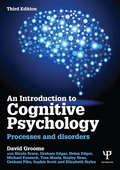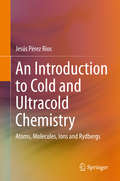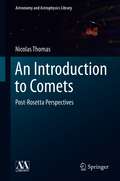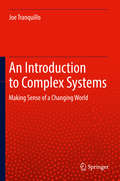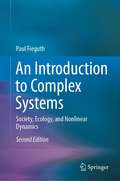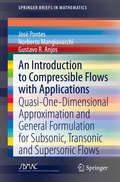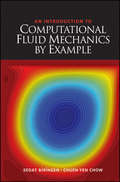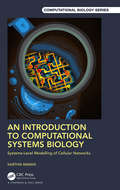- Table View
- List View
An Introduction to Biomedical Science in Professional and Clinical Practice
by Sarah Jane Pitt Jim CunninghamBiomedical Science in Professional and Clinical Practice is essential reading for all trainee biomedical scientists looking for an introduction to the biomedical science profession whether they are undergraduates following an accredited biomedical sciences BSc, graduate trainees or experienced staff with overseas qualifications. This book guides trainees through the subjects, which they need to understand to meet the standards required by the Health Professions Council for state registration. These include professional topics, laws and guidelines governing clinical pathology, basic laboratory techniques and an overview of each pathology discipline. It helps trainees at any stage of training and in any pathology discipline(s) to think creatively about how to gather evidence of their understanding and professional competence. By referring to specialist sources of information in each area, it helps students to explore particular topics in more depth and to keep up to date with professional and legal changes. It is also of value to any Training Officers who are looking for ideas while planning a programme of training for a trainee biomedical scientist. The book includes basic principles of working in the pathology laboratory including laws and regulations, which must be observed, such as health and safety, data protection and equal opportunities laws and guidelines. Practical exercises are included throughout the book with examples of coursework, suggestions for further exercises and self -assessment. Summary boxes of key facts are clearly set out in each chapter and ideas for group/tutorial discussions are also provided to enhance student understanding.
An Introduction to Bioreactor Hydrodynamics and Gas-Liquid Mass Transfer
by Enes Kadic Theodore J. HeindelReviews and compares the major types of bioreactors, defines their pros and cons, and identifies research needs and figures of merit that have yet to be addressedDescribes common modes of operation in bioreactorsCovers the three common bioreactor types, including stirred-tank bioreactors, bubble column bioreactors, and airlift bioreactorsDetails less common bioreactors types, including fixed bed bioreactors and novel bioreactor designsDiscusses advantages and disadvantages of each bioreactor and provides a procedure for optimal bioreactor selection based on current process needsReviews the problems of bioreactor selection globally while considering all bioreactor options rather than concentrating on one specific bioreactor type
An Introduction to Boundary Element Methods (Symbolic And Numeric Computation Ser. #4)
by Prem K. KytheThe finite element and the boundary element methods are the two most important developments in numerical mathematics to occur in this century. Many engineering and mathematics graduate curricula now include a course in boundary element methods. Such a course must cover numerical methods, basic methodology to real problems, and interactive computer usage. Both theory and applications, necessary for applied courses, are available in this new textbook.An Introduction to Boundary Element Methods is logically organized and easy to read. The topics are carefully selected and meticulously presented. Applications are described for use in identifying potential problems and for heat transfer, diffusion equations, linear elasticity, water waves, ocean acoustics, acoustic scattering, aerodynamics, porous media, and simple laminar flows.More than 20 computer subroutines help develop and explain the computational aspect of the subject. Hundreds of figures, exercises, and solved examples supplement text and help clarify important information.The computer programs have been tested on some benchmark problems. Even in single precision the results are more accurate and better than those obtained from available Fortran programs.
An Introduction to Brain and Behavior
by Bryan Kolb Ian Q. Whishaw G. Campbell TeskeyFrom authors Bryan Kolb and Ian Whishaw, and new coauthor G. Campbell Teskey, An Introduction to Brain and Behavior offers a unique inquiry-based introduction to behavioral neuroscience, with each chapter focusing on a central question (i. e. , "How Does the Nervous System Function?"). It also incorporates a distinctive clinical perspective, with examples showing students what happens when common neuronal processes malfunction. Now this acclaimed book returns in a thoroughly up-to-date new edition. Founders of a prestigious neuroscience institute at the University of Lethbridge in Alberta, Canada, Kolb and Whishaw are renowned as both active scientists and teachers. G. Campbell Teskey of the University of Calgary, also brings to the book a wealth of experience as a researcher and educator. Together, they are the ideal author team for guiding students from a basic understanding the biology of behavior to the very frontiers of some of the most exciting and impactful research being conducted today. The new edition also has its own dedicated version of Worth Publishers' breakthrough online course space, LaunchPad, giving it the most robust media component of any textbook for the course.
An Introduction to Brain and Behavior,Third Edition
by Bryan Kolb Ian Q. WhishawThe distinctive approach to contemporary brain science engages students by answering the basic questions about the interplay between brain and behavior --answers that incorporate the latest clinical and technological developments in research with fascinating case studies.
An Introduction to C*-Algebras and Noncommutative Geometry (Birkhäuser Advanced Texts Basler Lehrbücher)
by Heath EmersonThis is the first textbook on C*-algebra theory with a view toward Noncommutative Geometry. Moreover, it fills a gap in the literature, providing a clear and accessible account of the geometric picture of K-theory and its relation to the C*-algebraic picture. The text can be used as the basis for a graduate level or a capstone course with the goal being to bring a relative novice up to speed on the basic ideas while offering a glimpse at some of the more advanced topics of the subject. Coverage includes C*-algebra theory, K-theory, K-homology, Index theory and Connes’ Noncommuntative Riemannian geometry. Aimed at graduate level students, the book is also a valuable resource for mathematicians who wish to deepen their understanding of noncommutative geometry and algebraic K-theory. A wide range of important examples are introduced at the beginning of the book. There are lots of excellent exercises and any student working through these will benefit significantly. Prerequisites include a basic knowledge of algebra, analysis, and a bit of functional analysis. As the book progresses, a little more mathematical maturity is required as the text discusses smooth manifolds, some differential geometry and elliptic operator theory, and K-theory. The text is largely self-contained though occasionally the reader may opt to consult more specialized material to further deepen their understanding of certain details.
An Introduction to Celestial Mechanics
by Richard FitzpatrickThis accessible text on classical celestial mechanics, the principles governing the motions of bodies in the Solar System, provides a clear and concise treatment of virtually all of the major features of solar system dynamics. Building on advanced topics in classical mechanics such as rigid body rotation, Langrangian mechanics, and orbital perturbation theory, this text has been written for advanced undergraduates and beginning graduate students in astronomy, physics, mathematics, and related fields. Specific topics covered include Keplerian orbits, the perihelion precession of the planets, tidal interactions between the Earth, Moon, and Sun, the Roche radius, the stability of Lagrange points in the three-body problem, and lunar motion. More than 100 exercises allow students to gauge their understanding, and a solutions manual is available to instructors. Suitable for a first course in celestial mechanics, this text is the ideal bridge to higher level treatments.
An Introduction to Celestial Mechanics (Dover Books on Astronomy)
by Forest Ray MoultonAn unrivaled text in the field of celestial mechanics, Moulton's theoretical work on the prediction and interpretation of celestial phenomena has not been superseded. By providing a general account of all parts of celestial mechanics without an over-full treatment of any single aspect, by stating all the problems in advance, and, where the transformations are long, giving an outline of the steps which must be made, and by noting all the places where assumptions have been introduced or unjustified methods employed, Moulton has insured that his work will be valuable to all who are interested in the subject.The text is divided into ten chapters which progress logically in terms of the difficulty of their subject matter. They are: Fundamental Principles and Definitions, Rectilinear Motion, Central Forces, The Potential and Attractions of Bodies, The Problem of Two Bodies, The Determination of Orbits, The General Integrals of the Problem of n Bodies, The Problem of Three Bodies, Perturbations - Geometrical Considerations, and Perturbations - Analytical Method. Important topics cove red include general equations, motion of falling particles, the heat of the sun, simultaneous differential equations, examples where J is a function of the coordinates alone, the universality of Newton's law, determination of the orbit from the law of force, attractions of simple solids, potential and attractions of simple bodies and ellipsoids, Ivory's method and level surfaces, elements of orbits, expansions and positions in orbits, transformations of coordinates, the Laplacian and Gaussian methods of determining orbits, motion of center of mass and area integrals, motion of the infinitesimal body, surfaces of zero relative velocity, effects of the components of the disturbing force, lunar theory, method of computing perturbations, and the perturbative function.Each chapter is followed by a historical sketch and bibliography pertaining to that subject. Over 200 problems appear at key points in the text, many of them answered.
An Introduction to Ceramics (Lecture Notes in Chemistry #86)
by Roman PampuchThis book embraces both traditional and advanced ceramics produced from synthetic or deeply transformed natural raw materials. Following the path of ceramic innovation, this introduction explains electric properties of ceramic conductors, like high-temperature superconductors, reflects on the interaction of material and electromagnetic radiation, presents the importance of voids and defects in the material, and provides an outlook on most recent developments in the field of ceramics, such as smart or self-healing materials . It provides a quick grasp of the main points of ceramic thinking and is an ideal starting point for students in the field of chemistry, materials science or solid state physics.
An Introduction to Chemical Kinetics
by Michel SoustelleThis book is a progressive presentation of kinetics of the chemical reactions. It provides complete coverage of the domain of chemical kinetics, which is necessary for the various future users in the fields of Chemistry, Physical Chemistry, Materials Science, Chemical Engineering, Macromolecular Chemistry and Combustion. It will help them to understand the most sophisticated knowledge of their future job area. Over 15 chapters, this book present the fundamentals of chemical kinetics, its relations with reaction mechanisms and kinetic properties. Two chapters are then devoted to experimental results and how to calculate the kinetic laws in both homogeneous and heterogeneous systems. The following two chapters describe the main approximation modes to calculate these laws. Three chapters are devoted to elementary steps with the various classes, the principles used to write them and their modeling using the theory of the activated complex in gas and condensed phases. Three chapters are devoted to the particular areas of chemical reactions, chain reactions, catalysis and the stoichiometric heterogeneous reactions. Finally the non-steady-state processes of combustion and explosion are treated in the final chapter.
An Introduction to Chemistry
by Michael Mosher Paul KelterThis textbook is written to thoroughly cover the topic of introductory chemistry in detail—with specific references to examples of topics in common or everyday life. It provides a major overview of topics typically found in first-year chemistry courses in the USA. The textbook is written in a conversational question-based format with a well-defined problem solving strategy and presented in a way to encourage readers to “think like a chemist” and to “think outside of the box.” Numerous examples are presented in every chapter to aid students and provide helpful self-learning tools. The topics are arranged throughout the textbook in a "traditional approach" to the subject with the primary audience being undergraduate students and advanced high school students of chemistry.
An Introduction to Cluster Science
by Paul-Gerhard Reinhard Phuong Mai Dinh Eric SuraudFilling the need for a solid textbook, this short primer in cluster science is ideal for a one-semester lecture for advanced undergraduate students. It is based on a series of lectures given by the well-established and recognized authors for the past ten years. The book covers both the basics of the domain as well as up-to-date developments. It can be divided roughly into two parts. The first three chapters introduce basic concepts of cluster science. Chapter 1 provides a general introduction, complemented by chapter 2 on experimental and chapter 3 on theoretical aspects. The second half of the book is devoted to a systematic presentation of free cluster properties, and to a thorough discussion of the impact of clusters in other domains of science. These explicitly worked-out links between cluster physics and other research areas are unique both in terms of fundamental aspects and of applications, and cannot be found elsewhere in the literature. Also suitable for researchers outside of the field looking for an introduction to cluster science.
An Introduction to Clustering with R (Behaviormetrics: Quantitative Approaches to Human Behavior #1)
by Maria Brigida Ferraro Paolo Giordani Francesca MartellaThe purpose of this book is to thoroughly prepare the reader for applied research in clustering. Cluster analysis comprises a class of statistical techniques for classifying multivariate data into groups or clusters based on their similar features. Clustering is nowadays widely used in several domains of research, such as social sciences, psychology, and marketing, highlighting its multidisciplinary nature. This book provides an accessible and comprehensive introduction to clustering and offers practical guidelines for applying clustering tools by carefully chosen real-life datasets and extensive data analyses. The procedures addressed in this book include traditional hard clustering methods and up-to-date developments in soft clustering. Attention is paid to practical examples and applications through the open source statistical software R. Commented R code and output for conducting, step by step, complete cluster analyses are available. The book is intended for researchers interested in applying clustering methods. Basic notions on theoretical issues and on R are provided so that professionals as well as novices with little or no background in the subject will benefit from the book.
An Introduction to Cluttering: A Practical Guide for Speech-Language Pathology Students, Clinicians, and Researchers
by Yvonne van Zaalen Isabella ReichelAn Introduction to Cluttering explores the speech disorder of cluttering, offering concrete, evidence-based methods for its diagnosis and treatment.Cluttering is a globally recognized communication disorder, yet it is often poorly understood. This book presents a historical overview of the efforts of pioneers in the field to demystify the cluttering disorder, before introducing the aetiology and symptoms of cluttering from several perspectives: physiological, psycho-linguistic, neurological, social, affective, and cognitive. It also provides an in-depth discussion of the identification, differential diagnosis, and assessment of cluttering, using current and advanced diagnostic procedures before explaining the rationales and unique, innovative procedures for evidence-based treatments of cluttering. Engaging practical examples and theory boxes are featured throughout the book.Providing effective and user-friendly procedures for cluttering diagnosis and intervention, this book is an essential read for all current and future speech and language therapists.
An Introduction to Cochran-Mantel-Haenszel Testing and Nonparametric ANOVA (Wiley Series in Probability and Statistics)
by J. C. Rayner G. C. Livingston Jr.An Introduction to Cochran-Mantel-Haenszel Testing and Nonparametric ANOVA Complete reference for applied statisticians and data analysts that uniquely covers the new statistical methodologies that enable deeper data analysis An Introduction to Cochran-Mantel-Haenszel Testing and Nonparametric ANOVA provides readers with powerful new statistical methodologies that enable deeper data analysis. The book offers applied statisticians an introduction to the latest topics in nonparametrics. The worked examples with supporting R code provide analysts the tools they need to apply these methods to their own problems. Co-authored by an internationally recognised expert in the field and an early career researcher with broad skills including data analysis and R programming, the book discusses key topics such as: NP ANOVA methodology Cochran-Mantel-Haenszel (CMH) methodology and design Latin squares and balanced incomplete block designs Parametric ANOVA F tests for continuous data Nonparametric rank tests (the Kruskal-Wallis and Friedman tests) CMH MS tests for the nonparametric analysis of categorical response data Applied statisticians and data analysts, as well as students and professors in data analysis, can use this book to gain a complete understanding of the modern statistical methodologies that are allowing for deeper data analysis.
An Introduction to Cognitive Psychology: Processes and Disorders
by David GroomeAn Introduction to Cognitive Psychology: Processes and Disorders provides a comprehensive, yet accessible, overview of the field for undergraduate students. The fourth edition has been thoroughly revised throughout to provide a comprehensive introduction to the core topics of cognition, including memory, perception, thinking, and language. Uniquely, alongside coverage of normal cognitive function, the book also includes chapters on clinical disorders such as agnosia, amnesia, and aphasia, providing a more balanced insight into the nature of cognition and its related disorders. Key features: Completely revised and updated throughout to provide a comprehensive overview of current thinking in the field Accessibly written by experienced textbook authors and academic experts, including Michael Eysenck and Sophie Scott A new chapter on Problem Solving, written by Fernand Gobet, a leading authority in the field Greater coverage of neuropsychological disorders, with additional coverage of brain imaging research Features a wealth of real-world examples throughout to bring research to life Specially designed textbook features, chapter summaries, further reading, and a glossary of key terms An Introduction to Cognitive Psychology will appeal to all students on an undergraduate psychology degree course, as well as to those studying in related clinical professions.
An Introduction to Cognitive Psychology: Processes and disorders
by David GroomeDavid Groome with Nicola Brace, Graham Edgar, Helen Edgar, Michael Eysenck, Tom Manly, Hayley Ness, Graham Pike, Sophie Scott, and Elizabeth Styles. An Introduction to Cognitive Psychology: Processes and Disorders is a comprehensive introductory textbook for undergraduate students. The third edition of this well-established text has been completely revised and updated to cover all the key areas of cognition, including perception, attention, memory, thinking and language. Uniquely, alongside chapters on normal cognitive function, there are chapters on related clinical disorders (agnosia, amnesia, thought disorder and aphasia) which help to provide a thorough insight into the nature of cognition. Key features: Completely revised and updated throughout to provide a comprehensive overview of current thinking in the field Accessibly written and including new authors, including Sophie Scott, Tom Manly, Hayley Ness, and Elizabeth Styles, all established experts in their field A new chapter on Emotion and Cognition, written by Michael Eysenck, the leading authority in the field Greater coverage of neuropsychological disorders, with additional material from the latest brain imaging research that has completely revolutionized neuropsychology Specially designed textbook features, chapter summaries, further reading, and a glossary of key terms A companion website featuring an extensive range of online resources for both teachers and students. Written to cover all levels of ability using helpful figures and illustrations, An Introduction to Cognitive Psychology has sufficient depth to appeal to the most able students while the clear and accessible text, written by experienced teachers, will help students who find the material difficult. It will appeal to any student on an undergraduate psychology degree course, as well as to medical students and those studying in related clinical professions such as nursing.
An Introduction to Cold and Ultracold Chemistry: Atoms, Molecules, Ions and Rydbergs
by Jesús Pérez RíosThis book provides advanced undergraduate and graduate students with an overview of the fundamentals of cold and ultracold chemistry. Beginning with definitions of what cold and ultracold temperatures mean in chemistry, the book then takes the student through the essentials of scattering theory (classical and quantum mechanical), light-matter interaction, reaction dynamics and Rydberg physics. The author aims to show the reader the richness of the topic while motivating students to understand the fundamentals of these intriguing reactions and underlying connecting relationships. Including material which was previously only found in specialized review articles, this book provides students working in the fields of ultracold gases, chemical physics and physical chemistry with the tools they need to immerse themselves in the realm of cold and ultracold chemistry. This book opens up the exciting chemical laws which govern chemistry at low temperatures to the next generation of researchers.
An Introduction to Comets: Post-Rosetta Perspectives (Astronomy and Astrophysics Library)
by Nicolas ThomasWritten by a leading expert on comets, this textbook is divided into seven main elements with a view to allowing advanced students to appreciate the interconnections between the different elements. The author opens with a brief introductory segment on the motivation for studying comets and the overall scope of the book. The first chapter describes fundamental aspects most usually addressed by ground-based observation. The author then looks at the basic physical phenomena in four separate chapters addressing the nucleus, the emitted gas, the emitted dust, and the solar wind interaction. Each chapter introduces the basic physics and chemistry but then new specific measurements by Rosetta instruments at comet Churyumov-Gerasimenko are brought in. A concerted effort has been made to distinguish between established fact and conjecture. Deviations and inconsistencies are brought out and their significance explained. Links to previous observations of comets Tempel 1, Wild 2, Hartley 2, Halley and others are made. The author then closes with three smaller chapters on related objects, the loss of comets, and prospects for future exploration. This textbook includes over 275 graphics and figures – most of which are original. Thorough explanations and derivations are included throughout the chapters. The text is therefore designed to support MSc. students and new PhD students in the field wanting to gain a solid overview of the state-of-the-art.
An Introduction to Complex Systems: Making Sense of a Changing World
by Joe TranquilloThis book explores the interdisciplinary field of complex systems theory. By the end of the book, readers will be able to understand terminology that is used in complex systems and how they are related to one another; see the patterns of complex systems in practical examples; map current topics, in a variety of fields, to complexity theory; and be able to read more advanced literature in the field. The book begins with basic systems concepts and moves on to how these simple rules can lead to complex behavior. The author then introduces non-linear systems, followed by pattern formation, and networks and information flow in systems. Later chapters cover the thermodynamics of complex systems, dynamical patterns that arise in networks, and how game theory can serve as a framework for decision making. The text is interspersed with both philosophical and quantitative arguments, and each chapter ends with questions and prompts that help readers make more connections.
An Introduction to Complex Systems: Society, Ecology, and Nonlinear Dynamics
by Paul FieguthComplex Systems lie at the heart of a variety of large-scale phenomena of great significance - global warming, ice ages, water, poverty, pandemics - and this text uses these case studies as motivations and contexts to explore complex systems and related topics of nonlinear dynamics and power-law statistics. Although detailed mathematical descriptions of these topics can be challenging, the consequences of a system being nonlinear, power-law, or complex are in fact quite accessible. This book blends a tutorial approach to the mathematical aspects of complex systems together with a complementary narrative on the global/ecological/societal implications of such systems. Nearly all engineering undergraduate courses focus on mathematics and systems which are small scale, linear, and Gaussian. Unfortunately there is not a single large-scale ecological or social phenomenon that is scalar, linear, and Gaussian. This book offers insights to better understand the large-scale problems facing the world and to realize that these cannot be solved by a single, narrow academic field or perspective. Instead, the book seeks to emphasize understanding, concepts, and ideas, in a way that is mathematically rigorous, so that the concepts do not feel vague, but not so technical that the mathematics get in the way. The book is intended for students in technical domains such as engineering, computer science, physics, mathematics, and environmental studies. This second edition adds nine new examples, over 30 additional problems, 50 additional figures, and three new chapters offering a detailed study of system decoupling, extensive solutions to chapter problems, and a timely discussion on the complex systems challenges associated with COVID-19 and pandemics in general.
An Introduction to Compressible Flows with Applications: Quasi-One-Dimensional Approximation and General Formulation for Subsonic, Transonic and Supersonic Flows (SpringerBriefs in Mathematics)
by José Pontes Norberto Mangiavacchi Gustavo R. AnjosThis book offers a concise and practical survey of the principles governing compressible flows, along with selected applications.It starts with derivation of the time-dependent, three-dimensional equation of compressible potential flows, and a study of weak waves, including evaluation of the sound speed in gases. The following chapter addresses quasi-one-dimensional flows, the study of normal shock waves, and flow in ducts with constant cross section subjected to friction and/or heat transfer. It also investigates the effects of friction and heat transfer in ducts with variable cross section. The chapter ends by pointing to the analogy between one-dimensional compressible flows and open channel hydraulics.Further, the book discusses supersonic flows, including the study of oblique shock waves, and supersonic flows over corners and wedges. It also examines Riemann problems, numerical resolution of the wave equation, and of nonlinear hyperbolic problems, including propagation of strong waves. A subsequent chapter focuses on the small perturbation theory of subsonic, transonic and supersonic flows around slender bodies aligned or almost aligned to the uniform inflow. In particular, it explores subsonic and supersonic flows over a wavy wall. Lastly, an appendix with a short derivation of the Fluid Mechanics basic equations is included.The final chapter addresses the problem of transonic flows where both subsonic and supersonic are present. Lastly, an appendix with a short derivation of the Fluid Mechanics basic equations is included.Illustrated with several practical examples, this book is a valuable tool to understand the most fundamental mathematical principles of compressible flows. Graduate Mathematics, Physics and Engineering students as well as researchers with an interest in the aerospace sciences benefit from this work.
An Introduction to Computational Fluid Mechanics by Example
by Chuen-Yen Chow Sedat BiringenThis new book builds on the original classic textbook entitled: An Introduction to Computational Fluid Mechanics by C. Y. Chow which was originally published in 1979. In the decades that have passed since this book was published the field of computational fluid dynamics has seen a number of changes in both the sophistication of the algorithms used but also advances in the computer hardware and software available. This new book incorporates the latest algorithms in the solution techniques and supports this by using numerous examples of applications to a broad range of industries from mechanical and aerospace disciplines to civil and the biosciences. The computer programs are developed and available in MATLAB. In addition the core text provides up-to-date solution methods for the Navier-Stokes equations, including fractional step time-advancement, and pseudo-spectral methods. The computer codes at the following website: www.wiley.com/go/biringen
An Introduction to Computational Systems Biology: Systems-Level Modelling of Cellular Networks (Chapman & Hall/CRC Computational Biology Series)
by Karthik Raman"This is a very comprehensive read that provides a solid base in computational biology. The book is structured in 4 parts and 14 chapters which cover all the way from the more basic concepts to advanced material, including the state-of-the-art methodologies in synthetic and systems biology. This is a bedside book for those researchers embarking to do investigation in computational biology and a great office companion for anyone working on systems and synthetic biology." -- Rodrigo Ledesma Amaro, Lecturer, Imperial College London "This is a fantastic book. It offers an elegant introduction to both classical and modern concepts in computational biology. To the uninitiated, it is a terrific first read, bringing alive the glory of the past and the promise of the future. To the interested, it handholds and offers a springboard to dive deep. To the practitioner, it serves as a valuable resource bringing together in a panoramic view many diverse streams that adorn the landscape." -- Narendra M. Dixit, Professor, Indian Institute of Science An Introduction to Computational Systems Biology: Systems-Level Modelling of Cellular Networks delivers a comprehensive and insightful account of applying mathematical modelling approaches to very large biological systems and networks—a fundamental aspect of computational systems biology. The book covers key modelling paradigms in detail, while at the same time retaining a simplicity that will appeal to those from less quantitative fields. Features A hands-on approach to modelling Covers a broad spectrum of modelling, from static networks to dynamic models and constraint-based models Thoughtful exercises to test and enable understanding of concepts State-of-the-art chapters on exciting new developments like community modelling and biological circuit design Emphasis on coding and software tools for systems biology This book is highly multi-disciplinary and will appeal to biologists, engineers, computer scientists, mathematicians and others.
